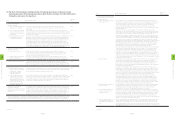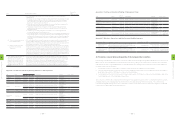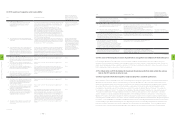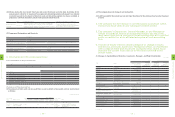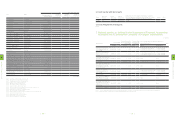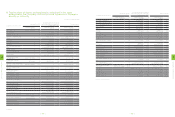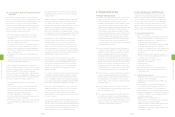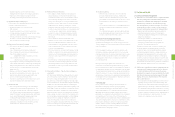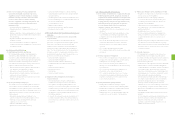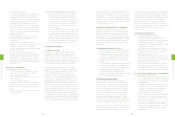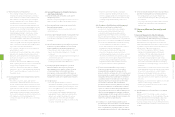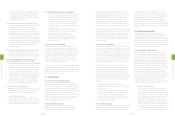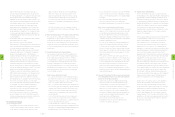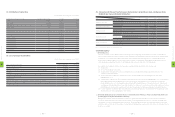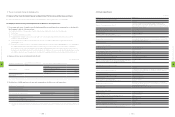HTC 2011 Annual Report Download - page 44
Download and view the complete annual report
Please find page 44 of the 2011 HTC annual report below. You can navigate through the pages in the report by either clicking on the pages listed below, or by using the keyword search tool below to find specific information within the annual report.
2-4. Safety and Health at Work Areas
(1) HTC continues to implement its occupational safety and
health management system, and upholds the ideals of
comprehensive environmental protection, proper health
and safety management, and progressive improvement
in energy efficiency. HTC provides and maintains a safe
and healthy working environment for its employees
to create a better quality of life for its employees,
customers, suppliers, and contractors.
• HTC identifies risk factors on a regular basis for work
operations
• HTC identifies relevant laws and regulations in order
to understand issues relating to applicability and
compliance with newly adopted and amended laws
and regulations.
• HTC sets up an annual target based on the results
of risk factor identification in order to determine
the future direction of its efforts and the desired
outcomes.
• HTC conducts internal and external audits.
• HTC establishes and modifies relevant procedures and
documents.
(2) Chemical Substances Management
• HTC confirms on a regular basis the type, quantity and
storage of the chemical substances used (including
management of the storage containers).
• HTC confirms the accuracy and completeness of
labeling of the chemical substances at each unit using
such substances.
• HTC confirms the accuracy and completeness of
information on the chemical substances.
• HTC conducts regular inspection tours of storage
environments and equipment safety; personnel are
required to wear basic protective gear when they
access chemical substances.
(3) Drinking Water Meets Quality Standard
• Drinking water equipment undergoes regular
maintenance to ensure the safety of drinking water.
• Drinking water equipment is regularly inspected and
maintained to ensure normal operation.
• Regular inspection of the drinking water quality are
conducted to ensure the safety of drinking water.
(4) HTC Ensures Workplace Safety and Employee Health
• Regular on-site inspections on the production facilities
to find out any on-site irregularities.
• Annual inspections on fire fighting equipment
to ensure its effectiveness and functionality, and
coordinating the facilities keepers to assist in the
handling of any irregularities.
• Safety inspections on the buildings to ensure
the completeness of the zoning, passages, and
partitioning facilities.
• Regular inspections of work environments
• HTC has established illumination standards at its
production facilities to ensure that work injuries or
occupational diseases do not occur due to poor
lighting.
• Regular ionizing electromagnetic wave detection tests
are carried out on electrical equipment on a yearly
basis, and monthly detection tests using infrared on all
electrical sockets to ensure there are no short circuits
or current overloads.
(5) Automatic Inspections
HTC has adopted a workplace accident prevention
and automatic inspection plan on a yearly basis in
accordance with laws and regulations and its experience
in actual operations. The automatic inspection plan is
implemented in eight areas:
• Establishment of an organization for safety and health
• Implementation of safety and health management:
Compiling statistics on accidents, analysis of accidents,
convening the labor safety and health committee,
inspections of accident prevention and management,
and management of contractors entering HTC plants.
• Safety and health education and training:
General safety and health education and training for
new employees and employees with work transfers,
general knowledge education on work hazards,
training for crews operating forklifts with load
capacities of one ton or more, training for supervisors
for the handling of organic solvents, ISO14000 and
OHSAS18000 management system training, and fire
fighting training.
• Standardized operating procedures and work safety
analysis:
HTC has adopted operating rules, maintenance rules,
and work safety procedures, and has additionally
adopted or amended work safety and health
guidelines, general knowledge education on work
hazards, and risk assessments.
(3) Ever since its founding, HTC has undertaken risk
assessments that target its production processes,
equipment, and use of chemical products. It adopts
measures necessary on the basis of the assessment
results in order to reduce accidents caused by
processes, equipment, or working environments, and
to reduce harmful exposure to chemical products.
Measures include:
• Chemical substances management
• Regular inspections of dangerous machinery and
equipment
• Employee education, training, and guidance, including
general labor safety and health related education and
first-aid training.
• Regular compilation and statistical analysis of
accidents occurred.
• Notice and explanations in relation to hazardous
conditions and dynamic management of the work area
at irregular intervals.
2-2. Safety and Health Training
(1) New Employee Education and Training
HTC has adopted an education and training plan for
environment, safety and health in accordance with
environment, safety and health laws and regulations and
its operational needs. It effectively implements appropriate
and effective education and training in these areas for
new employees by offering the following courses for new
employees based on their actual work needs:
• General safety and health education and training for
new employees (including EAP fire drills)
• Emergency self-protection and fire training
• General safety and health education and training for
employees with work transfers.
• General knowledge training on hazards for personnel
handling organic solvents.
(2) On-the-job Training for Employees
HTC adopts an on-the-job training plan for employees
in accordance with the requirements of relevant laws
and regulations and the employees' plan for their career
and development, and offers the following courses on a
yearly basis according to schedule or by a professional
training agency:
• General knowledge training on hazards for the
supervisor and personnel handling organic solvents.
• Training for crews operating forklifts with load
capacities of one ton or more.
• ISO14000 lead auditor training.
• OHSAS18000 internal auditor training.
• Safety and health managers/coordinator training.
• Class B dedicated wastewater and sewage treatment
specialist training.
• Credit program for labor safety and health personnel.
• Professional training for occupational health nurses at
the Council of Labor Affairs
• Credit program for nurses.
• Radiation safety training.
• Emergency self-protection and fire training.
• Emergency response drills.
2-3. Occupational accident prevention and emergency
response
(1) Prevention of occupational accidents and automatic
inspection plans.
Since its incorporation, HTC has always made the
prevention of occupational accidents a highest priority.
Each year, in accordance with relevant laws and
regulations and its experience with actual operations,
it draws up a "Labor Safety and Health Management
Plan." The Plan is implemented in the following areas, to
actualize our goal of occupational accident prevention
and automatic inspections, and to thereby achieve our
goal of zero accidents at the workplace.
• Safety and health organization
• Safety and health management
• Safety and health education and training
• Standard operation procedures and work safety
analysis
• Safety and health inspection
• Emergency response
• Medical care
• Safety and health activities
(2) Equipment safety management and emergency
response measures
• HTC has adopted an emergency drill plan and
established an emergency response mechanism.
• HTC organizes fire-fighting training drills for new
employees once a month in the plants, and carries out
simulation drills every half year for personnel in charge
of emergency self-protection and fire fighting, so that
the employees can immediately make proper use of
fire fighting equipment.
• In line with the emergency response mechanism, HTC
conducts evacuation drills so that during emergency
events employees can find the nearest safe routes for
evacuation.
4
CORPORATE GOVERNANCE
| 84 |
4
CORPORATE GOVERNANCE
| 85 |



